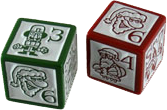This is possibly the most interesting review I’ve ever received. I’ve always had a soft spot for SnapDragons, so forgive me for posting it here.
Robert Preuss
Editor, Poetscollective.com
THE GAME’S AFOOT
Snapdragons, children, and the creative intellect
My sister’s pre-teen boys have been hooked on video gaming since they could manually operate joystick controllers. So have the two under-12s of a neighbor … and the neighbor himself.
The kids in Snapdragons (Dork Storm Press, 2005, available from Amazon.com) are into role-playing games. All of their play, in fact, reflects commercial role-playing games.
This makes for a somewhat esoteric collection of comics at an intersection of children’s animated motion picture entertainment (storyboard artist/illustrator Liz Rathke) and role-playing games writer/publisher/comic artist John Kovalic.
Subversive wisecracks (school cafeteria meatloaf is “fugglier” than zombies) layer the collection. While whimsy abounds, as it should, this particular collaboration addresses the creative imagination itself in a caring, patient manner, which suggests the book’s potential usefulness to parents hoping to understand creative children.
Such kids create their way out of boxes (much like comics creators), as in a most ambitious twist on Maurice Sendak’s much-beloved Where The Wild Things Are.
Here play intrudes on homework and chores. By putting her foot down, Mom not merely maintains decorum, but effects a full-blown existential dilemma. Precocious Jody and twin brother Jake discover that “you don’t need games you buy at a store to have a good time.”
The twins use their imagination to sail to where the Wild Things might be hanging out. Things take an ironic twist, or rather, several of them.
The creators of the comic don’t simply reference Sendak. They perform a full-scale détoumement, reconceptualizing the images, message and artefacts they’ve lifted from Sendak.
To these modern-day gaming kids, Sendak’s creatures just aren’t frightening.
“Not SCARY? But I rolled my terrible eyes” … “gnashed my terrible teeth.”
Jody and Jake recruit the monsters for (what else?) play in imaginary video, card, and board-based games based on the kids’ real-world collection (at this point one recalls the late Fred Rogers who took great pains to clearly mark the border between reality and fantasy play).
Furthermore the kids’ gaming thoroughly befuddles Sendak’s less-than-nightmarish creatures. Rathke’s visual rendering of the exasperation of the creatures is arresting and endearing in this high moment of deconstruction.
This is a Leonine twisted circle, however. There is one more twist. The imaginary creatures, it seems, have their own imaginations. Their way “out” of this “Ransom of Red Chief” quagmire is to convince the kids that their mother is calling and hasten to send the children home.
We could creatively apply a term created by Bertold Brecht for this particular plot twist: Umfunktionierung, a creative solution addressing a new “reality” or set of circumstances defining the rules of this particular fictional universe.
This, in turn, creates a kind of cognitive dissonance visible on the faces of the children.
This, then, is a solution not only worthy of the subject of this tribute, Sendak, but, in all its glorious, comic subversiveness, points to postmodern definition of a work of art as but liberated from the internal logic of the work of art itself … and not, as defined around the beginning of the 20th century, merely loosed from the repressed or “occult” concepts of the artist-as-prison.
The “Wild Things” are, when all is said and done, truly wild once more. And that is a very special, healthy minded moment, in a distinctly original and ingenious volume.
— Robert Preuss
****
And another nice review, this time from CuddleUp.com:
Recipient of the Origins Award, (“Here Be SnapDragons”) follows five young kids as they let their imagination consume them when role-playing. They turn mere household items into weapons for their epic battles waged as warriors and wizards against whatever evil force may be lurking.
John Kovalic and Liz Rathke do an excellent job of capturing a child’s mindset. Their jokes can be understood by adults and children alike, but their ability to identify certain signature traits about children and their interactions is uncanny. In one story, Jody feigns sickness in order to try a new present a little bit early. While her disgruntled brother Jake must go off to school and learn, Jody quests after her X-Cube Station 2 but discovers her plan is not as perfect as she thought. Another tale also gently mocks the classic children’s book Where the Wild Things Are.
The character drawings are simplistic, effective, and most importantly cute. Whether it be the protruding buck teeth of Cooper or the naive dotted eyes of Mitzi, the authors imbue a lot of energy with small amounts of change in their characters. Kovalic and Rathke also use the entire graphic novel, making sure the inside panels have something entertaining on them.
Light and whimsical, Here Be Snapdragons embodies just what childhood can be without hundreds of hours spent in front of the television, video game console, or computer screen. What strikes chords of harmony in this graphic novel is the level of imagination used by the kids—it warms the heart and leaves hope that some children out there are still getting lost in their own homemade adventures.


